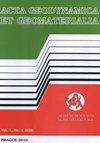Prediction of uniaxial compressive strength of carbonate rocks and cement mortar using artificial neural network and multiple linear regressions
IF 0.8
4区 地球科学
Q4 GEOCHEMISTRY & GEOPHYSICS
引用次数: 14
Abstract
Uniaxial compressive strength (UCS) represents one of the key mechanical properties used to characterize rocks along with the other important properties of porosity and density. While several studies have proved the accuracy of artificial intelligence in modeling UCS, some authors believe that the use of artificial intelligence is not practical in predicting. The present paper highlights the ability of an artificial neural network (ANN) as an accurate and revolutionary method with regression models, as a conventional statistical analysis, to predict UCS within carbonate rocks and mortar. Thus, ANN and multiple linear regressions (MLR) were applied to estimate the UCS values of the tested samples. For experimentation we carried out ultrasonic measurements on cubic samples before testing uniaxial compressive strength perpendicularly to the stress direction. The models were performed to correlate effective porosity, density and ultrasonic velocity to the UCS measurements. The resulting models would allow the prediction of carbonate rocks and mortar’s UCS values usually determined by laborious experiments. Although the results demonstrate the usefulness of the MLP method as a simple, practical and economical model, the ANN model is more accurate. ARTICLE INFO基于人工神经网络和多元线性回归的碳酸盐岩和水泥砂浆单轴抗压强度预测
单轴抗压强度(UCS)与孔隙度和密度等其他重要特性一样,是表征岩石的关键力学特性之一。虽然一些研究已经证明了人工智能在UCS建模中的准确性,但一些作者认为,人工智能在预测中并不实用。本文强调了人工神经网络(ANN)作为一种精确和革命性的回归模型方法的能力,作为传统的统计分析,预测碳酸盐岩和砂浆中的UCS。因此,采用人工神经网络和多元线性回归(MLR)来估计测试样本的UCS值。在垂直于应力方向测试单轴抗压强度之前,我们对立方样品进行了超声波测量。这些模型将有效孔隙度、密度和超声速度与UCS测量结果联系起来。由此产生的模型将允许预测碳酸盐岩和砂浆的UCS值,通常由艰苦的实验确定。虽然结果证明了MLP方法作为一种简单、实用和经济的模型的有效性,但人工神经网络模型更准确。条信息
本文章由计算机程序翻译,如有差异,请以英文原文为准。
求助全文
约1分钟内获得全文
求助全文
来源期刊

Acta Geodynamica et Geomaterialia
地学-地球化学与地球物理
CiteScore
2.30
自引率
0.00%
发文量
12
期刊介绍:
Acta geodynamica et geomaterialia (AGG) has been published by the Institute of Rock Structures and Mechanics, Czech Academy of Sciences since 2004, formerly known as Acta Montana published from the beginning of sixties till 2003. Approximately 40 articles per year in four issues are published, covering observations related to central Europe and new theoretical developments and interpretations in these disciplines. It is possible to publish occasionally research articles from other regions of the world, only if they present substantial advance in methodological or theoretical development with worldwide impact. The Board of Editors is international in representation.
 求助内容:
求助内容: 应助结果提醒方式:
应助结果提醒方式:


